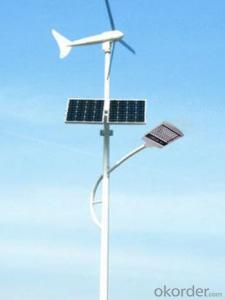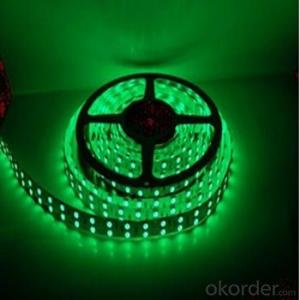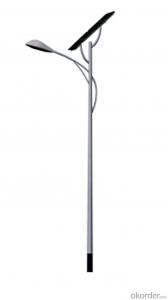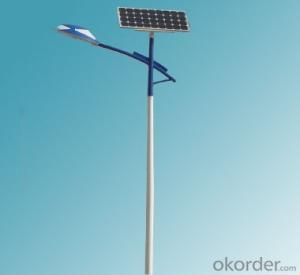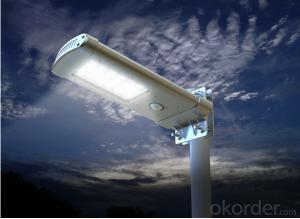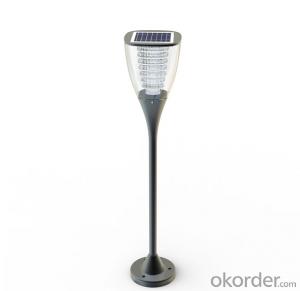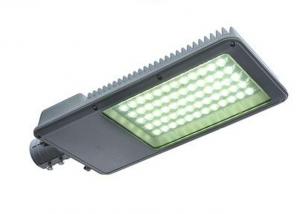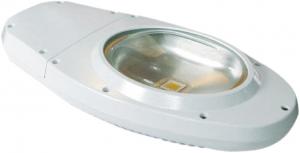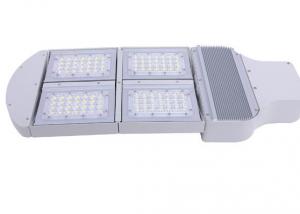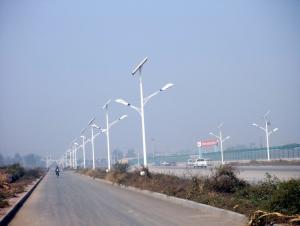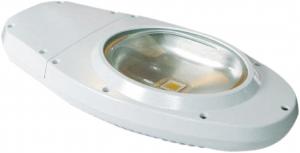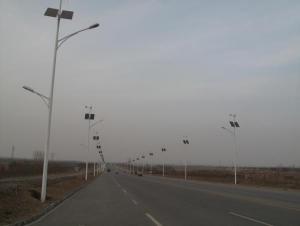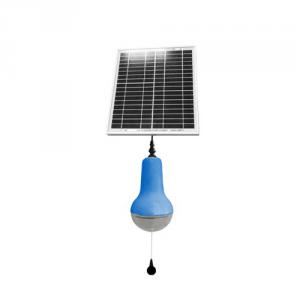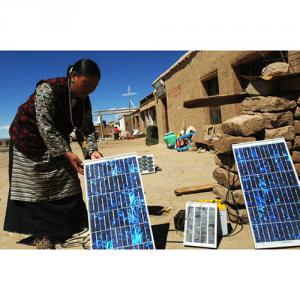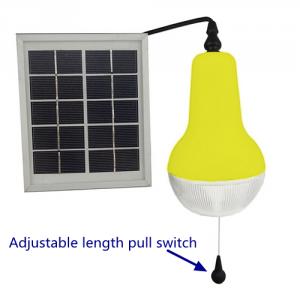Wind-Solar Hybrid Street Lights JMTF-002
- Loading Port:
- Shanghai
- Payment Terms:
- TT OR LC
- Min Order Qty:
- 10 pc
- Supply Capability:
- 10000 pc/month
OKorder Service Pledge
Quality Product, Order Online Tracking, Timely Delivery
OKorder Financial Service
Credit Rating, Credit Services, Credit Purchasing
You Might Also Like
| No. | Part | Description | lifetime | Guarantee |
| 1 | Lamp | 30-60W, imported LED chip 140-150lm/w, 4000-5500K. ( with invention patent) | 100,000hrs | 5years |
| 2 | Wind power generator | 1.2 grade wind can start the wind generator | 15years | 2years |
| 2 | Controller | digital programmable intelligent controller, switch on/off by light | 5years | 2years |
| 3 | Solar Panel | monocrystalline silicon or polycrystalline silicono(ptional), high conversion efficiency | 20years | 5years |
| 4 | Battery | High quality top brand maintenance-free solar storage gel or lead-acid battery, over charge and over discharge protection. | 8years | 3years |
| 5 | Pole | 4-12m high, zinc-plated steel, color optional | 20years | 10years |
| 6 | Accessories | Panel bracket, base anchor bolts, battery box, cables, fasteners etc. | 10years | 3years |
Remark:
| 1. work temperature: -30°C~+65°C. |
| 2. wind resistance:≥150km/h. |
| 3. protection grade: IP 65. |
- Q:What is the lifespan of solar light batteries?
- The lifespan of solar light batteries can vary depending on factors such as the quality of the battery, usage patterns, and environmental conditions. Generally, solar light batteries can last anywhere from 1 to 3 years before they start to degrade and require replacement. However, with proper care and maintenance, some high-quality batteries can last up to 5 years or more.
- Q:Do solar lights require any maintenance?
- Yes, solar lights do require some maintenance. This typically involves periodically cleaning the solar panel to ensure maximum sunlight absorption, replacing rechargeable batteries when needed, and checking for any loose connections or damaged parts.
- Q:Can solar lights be used for outdoor sports or recreational activities?
- Yes, solar lights can definitely be used for outdoor sports or recreational activities. Solar lights are designed to be used in outdoor environments and can provide sufficient lighting for various activities such as basketball, football, camping, hiking, or even night-time picnics. They can be installed in parks, playgrounds, sports fields, or any other outdoor space where additional lighting is needed. Solar lights harness the energy from the sun during the day, storing it in batteries, and then use that stored energy to illuminate the area at night. These lights are easy to install, require minimal maintenance, and are environmentally friendly as they rely on renewable energy. So whether you need lighting for a late-night game, a night-time hike, or simply to enhance the ambiance of an outdoor event, solar lights are a great option.
- Q:Can solar lights be used in parking lots or garages?
- Solar lights are a fantastic option for parking lots or garages. They have gained popularity as a preferred outdoor lighting solution in these areas. These lights are fueled by sunlight, which is converted into electricity using solar panels. Consequently, they don't need any wiring or electricity from the grid, making them both cost-effective and environmentally friendly. Throughout the night, solar lights can provide ample illumination, ensuring safety and security in parking lots and garages. Moreover, they are easy to install and require minimal maintenance. Thanks to technological advancements, solar lights now feature powerful LED bulbs that offer bright and consistent lighting, even in poorly lit areas. Overall, solar lights are an excellent choice for parking lots and garages, delivering energy savings, convenience, and enhanced safety.
- Q:Can solar lights be used in areas with heavy shade or tree cover?
- Solar lights are designed to harness sunlight and convert it into energy to power their light sources. However, in areas with heavy shade or tree cover, the availability of direct sunlight may be limited, which can affect the performance of solar lights. While solar lights can still function to some extent in shaded areas, their efficiency and brightness may be significantly reduced. The amount of shade or tree cover directly impacts the amount of sunlight that reaches the solar panels of the lights. If the shade is partial or the tree cover is not too dense, solar lights may still receive enough sunlight during certain parts of the day to charge their batteries and provide some illumination at night. However, in areas with heavy shade or dense tree cover, solar lights may struggle to receive enough sunlight to charge their batteries adequately. This can result in diminished light output and shorter operating times. Additionally, frequent interruptions in charging can cause the batteries of solar lights to degrade over time, reducing their overall lifespan. It is important to note that there are certain types of solar lights, such as those with separate solar panels connected by a cable, which can be advantageous in shaded areas. These lights allow the solar panel to be placed in a sunny location while the light itself can be positioned in a shaded area. This way, the solar panel can still receive ample sunlight, while the light can be installed in an area with heavy shade or tree cover. In conclusion, while solar lights can still be used in areas with heavy shade or tree cover, their efficiency and performance may be compromised. It is advisable to assess the level of shade or tree cover in the intended installation area and consider alternative lighting options, such as electric-powered lights, if direct sunlight is limited.
- Q:How do solar lights impact the environment?
- There are several ways in which the environment benefits from solar lights. Firstly, these lights utilize renewable energy from the sun, meaning they do not contribute to greenhouse gas emissions or air pollution. This is in contrast to traditional lights that rely on fossil fuels, which have a negative impact on the environment. Thus, solar lights play a role in reducing the carbon footprint and combating climate change. In addition, solar lights do not require an external power source. Consequently, they do not deplete natural resources or contribute to the extraction of fossil fuels. This, in turn, reduces the environmental damage caused by mining and drilling activities. Furthermore, solar lights have a longer lifespan compared to traditional lights. As a result, they generate less waste. These lights are designed to be durable and require minimal maintenance, resulting in a decrease in the amount of discarded materials that end up in landfills. When it comes to wildlife and ecosystems, solar lights have a minimal impact. Unlike traditional lights that attract insects and disrupt the natural behavior of animals, solar lights emit a softer and less intrusive light. This helps maintain the natural habitats and ecosystems by not disturbing the balance of nocturnal wildlife. Overall, solar lights have a positive impact on the environment. They reduce greenhouse gas emissions, conserve resources, minimize waste, and preserve wildlife habitats. Consequently, they are a sustainable and eco-friendly lighting solution that contributes to the creation of a cleaner and greener future.
- Q:How long do solar lights last?
- Solar lights typically last for about 4-6 years, depending on the brand and quality. However, with proper maintenance and care, they can last even longer. It's important to regularly clean the solar panels and replace the rechargeable batteries when needed to ensure optimal performance and longevity.
- Q:Can solar lights be used for signage and billboards?
- Yes, solar lights can be used for signage and billboards. Solar-powered lights are a sustainable and cost-effective option for illuminating signs and billboards, as they use renewable energy from the sun to generate light. They do not require any electrical wiring or connection to the grid, making them easy to install and maintain. Additionally, solar lights can provide continuous illumination even during power outages or in remote locations, making them an ideal choice for outdoor advertising.
- Q:Are solar lights suitable for use in historical or heritage sites?
- Solar lights can be a suitable option for use in historical or heritage sites, depending on various factors. One of the main advantages of solar lights is their ability to operate independently of the electrical grid, which makes them ideal for locations where preserving the site's original character and minimizing disruption is important. Solar lights can be easily installed without the need for extensive wiring or trenching, which is especially beneficial in protecting the integrity of historical or heritage sites. They can be strategically placed to enhance the aesthetics of the site while providing sufficient illumination for safety and security purposes. Moreover, solar lights are environmentally friendly as they rely on renewable energy sources. This aligns well with the preservation and sustainability objectives often associated with historical or heritage sites. By utilizing solar energy, these lights can contribute to reducing carbon emissions and minimizing the ecological impact on the site. However, before implementing solar lights in historical or heritage sites, careful consideration should be given to certain factors. These include the sensitivity of the site, the specific lighting requirements, and the need to ensure that the lights blend harmoniously with the overall ambiance. Additionally, it is essential to assess the availability of sunlight in the area. Solar lights require sufficient exposure to sunlight to charge their batteries effectively. Therefore, if a site is heavily shaded or located in an area with limited sunlight, alternative lighting options may need to be considered. In summary, solar lights can be a suitable choice for historical or heritage sites, offering the benefits of independence from the electrical grid, ease of installation, environmental friendliness, and the ability to enhance the site's aesthetics. However, careful evaluation of the site's specific needs and conditions is crucial to ensure the successful integration of solar lighting while preserving the historical and cultural significance of the location.
- Q:Can solar lights be used for airport runway or taxiway lighting?
- Yes, solar lights can be used for airport runway or taxiway lighting. They provide a cost-effective and environmentally friendly solution, as they are powered by renewable energy. However, their usage may be limited to certain airports or specific areas within airports, depending on factors such as available sunlight and the requirements of the aviation authorities.
1. Manufacturer Overview |
|
|---|---|
| Location | |
| Year Established | |
| Annual Output Value | |
| Main Markets | |
| Company Certifications | |
2. Manufacturer Certificates |
|
|---|---|
| a) Certification Name | |
| Range | |
| Reference | |
| Validity Period | |
3. Manufacturer Capability |
|
|---|---|
| a)Trade Capacity | |
| Nearest Port | |
| Export Percentage | |
| No.of Employees in Trade Department | |
| Language Spoken: | |
| b)Factory Information | |
| Factory Size: | |
| No. of Production Lines | |
| Contract Manufacturing | |
| Product Price Range | |
Send your message to us
Wind-Solar Hybrid Street Lights JMTF-002
- Loading Port:
- Shanghai
- Payment Terms:
- TT OR LC
- Min Order Qty:
- 10 pc
- Supply Capability:
- 10000 pc/month
OKorder Service Pledge
Quality Product, Order Online Tracking, Timely Delivery
OKorder Financial Service
Credit Rating, Credit Services, Credit Purchasing
Similar products
New products
Hot products
Hot Searches
Related keywords
